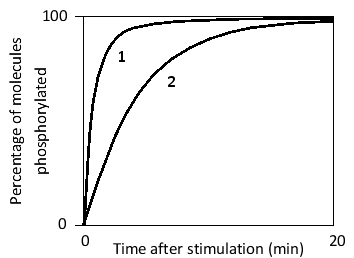Consider a signaling protein that can be phosphorylated by a dual-specificity protein kinase at two independent sites (one tyrosine and one serine residue), such that each site is phosphorylated in about 1% of the protein molecules under normal conditions. Phosphorylation at the first site has a short half-life, since a fast tyrosine phosphatase removes the phosphate soon after the residue is phosphorylated, whereas dephosphorylation at the second site-carried out by a serine/threonine phosphatase-is relatively slow. Upon activation of a signaling pathway, the concentration of the dual-specificity kinase increases several-fold rapidly. The phosphorylation state of the tyrosine and serine residues following stimulation is compared in the following graph. Which curve (1 or 2) do you think corresponds to the serine residue? Write down 1 or 2 as your answer.

Correct Answer:
Verified
View Answer
Unlock this answer now
Get Access to more Verified Answers free of charge
Q12: In the following simplified diagram, the activation
Q13: Cells can adapt to extracellular signal molecules
Q14: Which of the following events normally activates
Q15: In the following graphs, the cellular response,
Q16: In the following graphs, the cellular response,
Q18: Which of the following molecular mechanisms is
Q19: You grow a tumor-derived cell line in
Q20: Some signaling pathways in the cell are
Q21: Which of the following is a major
Q22: Sort the following events to reflect the
Unlock this Answer For Free Now!
View this answer and more for free by performing one of the following actions

Scan the QR code to install the App and get 2 free unlocks

Unlock quizzes for free by uploading documents